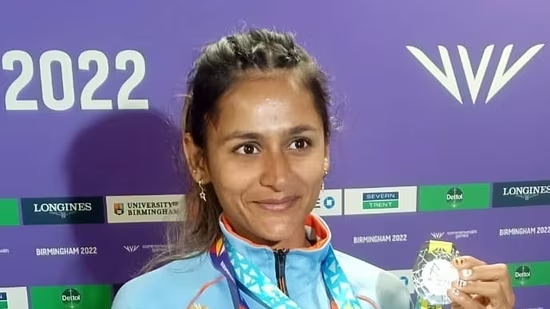Goswami, Sandeep are walking the talk
“Yaha pe race walking ke baare mein kisko pata hai (who here knows about race walking)?” Priyanka Goswami addressed the question to a sizeable gathering at a sponsor’s event in the city on Monday. A handful of arms were raised.  PREMIUM
PREMIUM
“Dekhiye, medal aane ke baad bhi 4-5 log ko hi pata hai (even after a medal only 4-5 people know about it),” Goswami said later with an accompanying chuckle.
The medal being referred to is a Commonwealth Games (CWG) silver, which Goswami won in Birmingham earlier this month with a national record timing of 43:38.83 in the women’s 10,000m race walk. A day later, Sandeep Kumar clinched bronze in the men’s event clocking a personal best 38:49.21.
Two Indians had medaled in race walking, a first at the CWG stage. Before the 2022 edition, only Harminder Singh—bronze in the 20km category at the 2010 New Delhi Games—had won a race walking medal for India at the CWG. The Birmingham CWG double isn’t a standalone recent addition to the country’s race walking CV. In March, the trio of Bhawna Jat, Ravina and Munita Prajapati won a first women's 20km team medal (bronze) at the World Athletics Race Walking Team Championships.
It’s a small group of around 10 elite national walkers—3-4 women and 6-7 men, Goswami said—that trains together at the Sports Authority of India centre in Bengaluru, largely detached from the increased spotlight and popularity wave to have hit Indian athletics.
The CWG medals have brought race walkers a touch closer to the mainstream of javelin throwers, sprinters, jumpers and steeplechasers, but still quite a long way off in a discipline considered one of the most technical and gruelling in athletics with categories ranging from 3000m all the way up to 50km.
“When I look at race walking, I don’t look at it as my event. I feel, what people think about this event. And I want to get rid of that feeling,” Goswami said. “Like the thought of an athlete running comes naturally to the public. I want the same for race walking too. Not that ‘yeh kaise matak rahe hai’.”
To be sure, neither of the two CWG medallists had themselves heard of race walking until they made the switch in sport. A gymnast in school, Goswami moved to athletics because she “wanted to run” until the Uttar Pradesh girl won a race walking competition she had randomly entered her name for. “I was so happy that I decided to stick to walking,” she said.
Kumar competed in local wrestling and kabaddi meets in his village in Haryana. His race-walking days began after his recruitment in the army in 2000. “I had completed my two years of training when the then race walking coach of the army spotted me and put me in the sport. I had not even heard of race walking before that,” the 36-year-old said.
Goswami said it took her almost half a year to get hold of the technique involved in it. “Even after 10 years of doing it, I’m yet to master it,” she added. In race walking, the athlete’s leg has to remain in contact with the ground at all times, and the knee straightened as the foot makes contact; fouls and disqualification due to faulty technique are common even at the elite level. And that is the reason why the seemingly simple walking act makes for an odd race walking visual.
“In my early days, my seniors would tell me, ‘chal kharab kar degi yeh event (this event will spoil your walking posture). But I don’t think it has affected my normal walking style too much,” Goswami said.
The national campers dedicate around two hours every morning to the “other style of walking” on an average day of training, while evenings are for lower-intensity workout and technical improvement sessions. Bulk of the physical strengthening work is reserved for the legs. “Because the entire load of your body falls on the legs. The knee too can’t bend,” Goswami said.
The gap at the Olympics and World Championships level though is still considerable for Indian race walkers, KT Irfan's 10th-place finish in 20km at the 2012 London Games being the occasional noteworthy exception. Goswami, who broke the 20km national record in February last year with 1:28.45, ended 17th at the Tokyo Olympics while Kumar, who won his third straight 20km national title this April, finished 23rd. Both were outside the top 30 in the Eugene Worlds before the CWG. However, medals at the CWG point at a sign of progress.
“We’ve had people walking 1:20 in 20km, which is world class,” Adille Sumariwalla, the chief of Athletics Federation of India that will now have HSBC as sponsors specifically aimed at supporting women athletes like Goswami, said. “In the 1982 Asian Games, Chand Ram won a gold medal (timing 1:29.29). Today, Priyanka is walking faster than that. So that is the sort of progression we’ve made—purely looking at it in terms of numbers.”
In terms of attracting more eyeballs and greater interest in the event, there’s a long way to go, and the race walkers are all too aware of that. But two medals at the CWG could be a good start to race walking gathering some momentum in India.
“Some years ago, even we didn’t believe we could win a medal in race walking at an event like the Commonwealth Games, forget about people outside. Now we’ve got two of them from one edition. So this could just be the beginning for race walking in the country,” Goswami said.
Experience unrestricted digital access with HT Premium
Explore amazing offers on HT + Economist Start 14 Days Free Trial Already Subscribed? Sign In
Disclaimer: The copyright of this article belongs to the original author. Reposting this article is solely for the purpose of information dissemination and does not constitute any investment advice. If there is any infringement, please contact us immediately. We will make corrections or deletions as necessary. Thank you.







